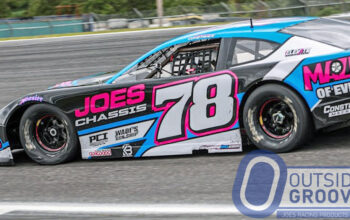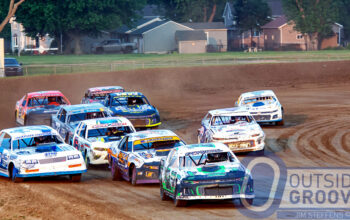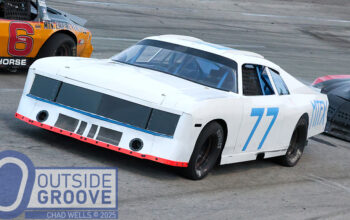Big rig racing returned with a splash, as the American Big Rig Series shown at Salem Speedway in Indiana. The series brought the trucks, and the fans responded.
“It’s balls-to-the-wall racing,” said Mike Morgan, the driver of Mackvader and one of the series’ spokespersons. “It is crazy, aggressive, and something you don’t often see — big rigs beating and banging, with metal crunching and rivets popping at 125 miles per hour.”
The series runs semi-trucks weighing 11,000 to 14,000 lb. Stock six-cylinder diesels made by CAT, Detroit and Mack power the vehicles.
“My truck has 1,000 horsepower and 3,000 lb-ft of torque,” Morgan said. “It’s torque that no one understands. The torque will take you all the way around an oval all day long. These trucks were built to haul 80,000 lb. They are robust, with a massive engine that spins more and pushes more so that 140 mph is no problem for these big trucks.”
The trucks have a front-to-rear weight percentage of 60/40. Drivers use different gear ratios for different tracks. They angle front axles; use weight jacking; leaf, coil, or airbag suspensions; and sway bars on the front, rear, or both. Teams run a lot of caster in the front axles, which creates camber. Water often cools the brakes. The trucks run highway-grade tires, but the teams will shave the tires down to 6/32″.
“Like an old muscle car, there is a lot of rear steer,” said Morgan. “To drive one, you have to be up on the wheel. You have to set the truck up right, don’t overpower the track, and then you haul ass. When one truck is faster, it is usually the driver that made it so.”
Morgan said drivers run the American Big Rig Series as a co-op. They hope to gain more races this season.
“We are looking for ½-mile paved racetracks for our tour, preferably in the Southeast, because the majority of the trucks are in North Carolina,” Morgan said. “We will consider 3/8 and 4/10-mile tracks.”
The success at Salem Speedway put an exclamation point on what they offer potential host tracks.
“The proof is in the pudding – we put butts in the stands,” said Morgan. “The people who saw the first Salem [Speedway] show will come back and bring their friends to the next show. The show will sell itself.”
Mike Adaskaveg has written hundreds of stories since the website’s inception. This year marks his 54th year of covering auto racing. Adaskaveg got his start working for track photographer Lloyd Burnham at Connecticut’s Stafford Motor Speedway in 1970. Since then, he’s been a columnist, writer, and photographer, in racing and in mainstream media, for several outlets, including the Journal Inquirer, Boston Herald, Stock Car Racing, and Speedway Illustrated. Among Adaskaveg’s many awards are the 1992 Eastern Motorsport Press Association (EMPA) Ace Lane Photographer of the Year and the 2019 National Motorsports Press Association (NMPA) George Cunningham Writer of the Year.





